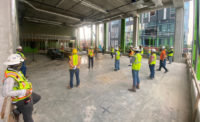COVID-19
Coronavirus Confusion in California
Firms unclear about shelter-in-place directives and orders

Confusion grew in California as construction businesses struggled to understand locally issued shelter-in-place and other COVID-19 related directives and orders that allow “essential” or vital services to continue onsite work; these include certain types of construction but definitions are far from clear.
For ENR’s latest coverage of the impacts of the COVID-19 pandemic, click here
“There is incredible uncertainty and confusion for our industry right now, for both private and public works construction,” says Emily Cohen, executive vice president at United Contractors (UCON), which represents more than 500 California contractors, vendors and engineering and design firms in heavy constructoin. “Our most pressing challenge is getting uniformity for our contractors and our industry as soon as possible from local, state and federal government.”
An order requires residents to stay home except to obtain or provide essential services, which currently includes construction affecting public works and infrastructure, while directives are a recommendation.
Earlier this week, Alameda, Contra Costa, Marin, Monterey, Sacramento, San Francisco, Santa Clara, Santa Cruz, San Mateo and Sonoma counties all issued shelter-in-place directives or orders. An order requires residents to stay home except to obtain or provide essential services, which currently includes construction affecting public works and infrastructure, while directives are a recommendation.
San Francisco’s shelter-in-place ordinance allows work to continue on construction of public works, housing, airport operations, water, sewer, gas, electrical, oil refining, roads and highways, public transportation, solid waste collection and removal, internet and telecommunications. Work must comply with social distancing standards where possible.
On March 18, San Francisco Public Works clarified its shelter-in place ordinance that made exemptions for continuing construction guidelines. Public Works' permit center is closed to in-person visits with staff working remotely to review previously submitted permits. New Public Works permit applications are being accepted, but applicants should expect delays while the shelter-in-place order is in effect, says Rachel Gordon, a spokesperson. Essential infrastructure projects, such as water supply and wastewater treatment, and housing, are prioritized.
“By nature, we aren’t a work-from-home industry,” says Cohen, who notes many UCON members may wish to continue essential works. “We are working with our union partners, government agencies, elected officials, counsel and industry partners to help guide them through the flood of issues they are facing related to payments, contracts, insurance, safety challenges and regulations, supply-chain delays and economic uncertainty. We are all in this together.”
Associated General Contractors of California reports an increase in work paused in Bay Area counties ... as contractors struggle to decipher if projects fall under varying counties' interpretation of 'essential' and county definitions vary.
It is too early to see and understand the full impact of California counties’ directives and orders, WSP told ENR. The firm is modifying some construction projects to comply with jurisdictional shelter-in-place demands. Public works construction projects are continuing for now.
“Other critical projects are being accelerated to support healthcare and other essential facilities to be able to support their community demands,” say John M. Fisher, WSP vice president and district manager of Northern California, and Sarah Kuchera, senior vice president and managing director for property and buildings, in a joint statement to ENR.
“Some clients may be advancing certain types of work to be ready for any federal or other stimulus funding that may be available. We are taking this day by day, if not hour by hour."
Associated General Contractors of California reports an increase in work paused in Bay Area counties as contractors struggle to decipher if projects fall under varying counties’ interpretation of “essential.” In particular, Santa Clara’s evolving definition is narrower than adjacent counties, creating confusion, says Peter Tateishi, CEO of AGC California.
“We need clarity from government, whether that’s at the local level, regional level, state or even federal – we need that clarity and that’s what we’re seeking,” says Tateishi. AGC CA is consistently hearing government officials acknowledge that construction continuation is a priority and will be part of any resiliency plan. “It’s not a failure of government by any means, it’s just a government is being very responsive and reactionary as it needs to be in a disaster dynamic which means we have to sort that out on the backend of this.”
Economic Relief Package
Los Angeles Mayor Eric Garcetti on March 18 announced an $11 million economic relief package for small businesses impacted by COVID-19. He said previously that a shelter-in-place order is not imminent for the city and that construction is essential and will continue. The mayor’s office did not immediately respond to repeated requests for additional comment.
Orange County issued an order prohibiting all public and private gatherings of “any number of people. including at place of work, occurring outside a single household or living unit…”, with exemptions for essential activities. County officials acknowledged March 18 that its initial press release ”created some confusion about the current health order.”
The county referred a reporter to its emergency operations center, but the phone number was busy.
“Businesses can call 211 and can get answers directly that way,” says Santa Clara County, but it would not provide additional information or clarification for its shelter-in-place order. In an email, the county referred a reporter to county issued guidelines.



